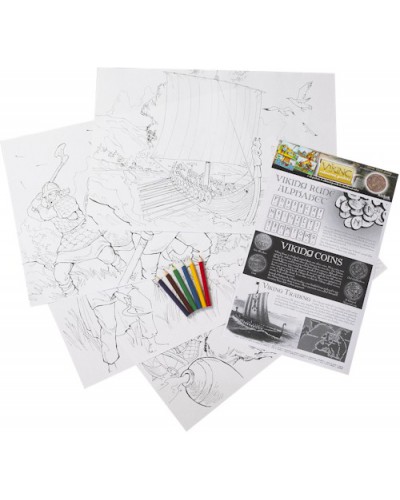Product Description: The Viking Colouring Posters consists of four A3 size colouring sheets, six colouring pencils and a Viking factsheet. The colouring posters include a single image of a Viking Village scene, the Vikings attacking a village, the Vikings ready for battle, and a poster depicting Viking longships at sea. The factsheet explains who the Vikings were, their Rune alphabet, Viking coins, the Vikings as traders and there is also a crossword to complete. There is a colourful header card that has pictures showing how the posters could be coloured in and information on a Viking coin and Alfred The Great. All are held in a clear cellophane bag.
Information: The Viking people came from three countries of Scandinavia: Denmark, Norway and Sweden. They were also known as the Norse people. They were mostly farmers, but some worked as craftsmen or traders. They spread through Europe and the North Atlantic in the period of vigorous Scandinavian expansion (AD 800-1050) known as the Viking Age.
The development of the Viking ship made this expansion possible. With its flexible hull and its keel and sail, the Viking ship was far superior to ships and boats used by other peoples at the time. These ships were called Longships. They were about 30m long and could travel at around 32km per hour. The Vikings carved the prow of their ships into elaborate shapes such as the head of a dragon or another animal.
Most people lived on farms. The Vikings lived in long rectangular houses made with upright timbers (wood), wattle and daub or stone. They were usually one room with a cooking fire in the middle. The smoke escaped through a hole in the roof. Animals and people lived in the same building. The animals lived in a byre at one end of the house and the people lived at the other. Men wore tunics and trousers and women wore a long dress with a pinafore over it. Their clothes were fastened with belts and brooches. They made their clothes from wool and linen.
The runic alphabet was known from the first century AD among all Germanic tribes around the North Sea and the Baltic Sea. The oldest version of the runic alphabet had 24 runes. It was used for writing on wood, bone and stone and was regarded as sacred.
The Vikings word for alphabet was “futhark” named after the first 6 letters in their runic alphabet.
Viking kings in England minted their own silver coins. These coins were minted by striking a blank silver disc between two iron dies. The Vikings, like the Saxons, used the penny as the basis of their currency. Although some round halfpence were issued, the usual method of making small change was to cut coins into halves and quarters. It was not until the late 9th century that coins were struck by the Vikings themselves. These were imitations of coins of Alfred the Great. It was later on that the Vikings added crosses, swords, birds and hammers.
Instead of fighting the Viking invaders, some English kings preferred to pay the Vikings to leave them in peace. These payments were called ‘Danegeld’ (meaning ‘Dane debt’ or Dane payment).
Tags: Viking, Educational, Colouring, Posters

